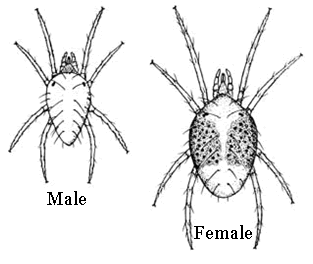Mites, spiders and ticks are not insects but belong to a closely related group called the arachnids. Adult and nymph mites have eight legs; the youngest mites (larvae) and insects have only six legs. Insects have antennae but mites do not. Also, mites will never have wings. Mites and some insects have piercing-sucking mouthparts so the damage to plants is often similar.

Pest mites remove chlorophyll and sap from host plants resulting in bleaching, yellowing or browning of the foliage. Initial symptoms are small yellow or whitish stippling (spots) that appears on the foliage where chlorophyll has been removed. Leaf or needle drop may be caused by dehydration due to loss of water by such feeding. In heavy infestations, plant vigor is often reduced and unsightly webbing may be seen on the foliage.
Monitoring or checking for mites should be done at least once a week during times of the year when pest mites are most likely to be active. To monitor, examine foliage with the aid of a hand lens or by striking a limb over a piece of white cardboard to detect any mites that dislodge onto the white surface. A few mites on a shrub or tree are not a serious concern because the plant can tolerate low numbers. Also, some of the mites may be beneficial ones that feed on the pest mites. Such beneficial predators are usually more active and run faster than pest mites. If early signs of injury are beginning to show on the plants and mite numbers are increasing, a spray treatment may be warranted. If monitoring indicates that a treatment is needed, a foliar spray with a miticide (acaricide) should be applied.
Two of the important pest mites in Connecticut are the two-spotted spider mite and the spruce spider mite. Both mites are very tiny, approximately 1/50 of an inch in length. The time for development from egg to adult requires 15 to 30 days. Because generations frequently overlap, mites of all stages can often be found on the same plant.
Two-spotted mite
These mites attack the foliage of ornamentals, vegetables and fruits. They are oval, green to yellow in color and have two dark spots on their backs. Two-spotted mites overwinter outside as adults in the soil or leaf litter. They may remain active indoors, however, on houseplants and greenhouse plants. The light yellowish eggs are pearl-like in appearance and are attached to the undersides of leaves or on stems. Two-spotted mites thrive in hot and dry weather and thus cause most of their injury during mid to late summer.
Spruce spider mite
These mites attack many conifers, especially spruce, arborvitae, hemlock, juniper and pine. Young spruce spider mites are pale green; adults may be reddish, dark green or nearly black with pink legs and spines. They are about the size of a pepper grain so a hand lens is helpful when monitoring. Winter eggs are brick red; summer eggs are dull brown. The eggs are laid on and around bud scales and at the bases of needles.
Unlike two-spotted mites, spruce spider mites are most active and damaging during the spring and fall when the temperatures are cooler and rainfalls are more frequent. These are also the best times to control spruce spider mites. Their activity and the effectiveness of control greatly decreases during hot summer weather. Older needles are attacked first, so the earliest injury is usually seen on the lower and inner parts of trees. Infestations can spread to the top portions of trees as the season progresses.
Mite Control
If a miticide is warranted, select the least toxic material whenever possible and be sure to achieve good spray coverage on the undersides of leaves or needles. Miticides that can be used include: dormant oil sprays, insecticidal soap, summer oils, and sulfur. Read the miticide label carefully and make sure that the plant to be treated is listed on the label. Also, check the label for harvest intervals (time between last application and harvest) on food crops. Beneficial mites may also be purchased and released to aid on the control of pest mites.
Despite good cultural practices, pests and diseases at times may appear. Chemical control should be used only after all other methods have failed.
For pesticide information or other questions please call toll free: 877-486-6271.
Revised by the UConn Home & Garden Education Center, 2016.